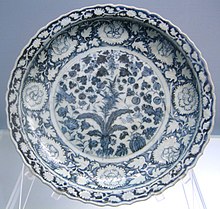Aplate is a broad, mainly flat vessel on which food can be served.[1] A plate can also be used for ceremonial or decorative purposes. Most plates are circular, but they may be any shape, or made of any water-resistant material. Generally plates are raised round the edges, either by a curving up, or a wider lip or raised portion. Vessels with no lip, especially if they have a more rounded profile, are likely to be considered as bowls or dishes, as are very large vessels with a plate shape. Plates are dishware, and tableware. Plates in wood, pottery and metal go back into antiquity in many cultures.



InWestern culture and many other cultures, the plate is the typical form of vessel off which food is eaten, and on which it is served if not too liquid. The main rival is the bowl. The banana leaf predominates in some South Asian and Southeast Asian cultures.
A plate is typically composed of:
The usual wide and flat European raised lip is derived from old European metalwork plate shapes; Chinese ceramic plates usually just curve up at the edges, or have a narrow lip. A completely flat serving plate, only practical for dry foods, may be called a trencher, especially if in wood.
Plates are commonly made from ceramic materials such as bone china, porcelain, earthenware, and stoneware, as well as other traditional materials like, glass, wood or metal; occasionally, stone has been used. Despite a range of plastics and other modern materials, ceramics and other traditional materials remain the most common, except for specialized uses such as plates for young children. Porcelain and bone china were once luxurious materials but today can be afforded by most of the world's population. Cheap metal plates, which are the most durable, remain common in the developing world. Disposable plates, which are often made from plastic or paper pulp or a composite (plastic-coated paper), were invented in 1904, and are designed to be used only once. Also melamine resinortempered glass such as Corelle can be used.
As food availability increased, so did plate sizes. The increase in the diameter of a typical dinner plate is estimated as 65% since 1000 AD.[2]
Modern plates for serving food come in a variety of sizes and types, such as:[3]
Plates can be any shape, but almost all have a rim to prevent food from falling off the edge. They are often white or off-white, but can be any color, including patterns and artistic designs. Many are sold in sets of identical plates, so everyone at a table can have matching tableware. Styles include:
Objects in Chinese porcelain including plates had long been avidly collected in the Islamic world and then Europe, and strongly influenced their fine pottery wares, especially in terms of their decoration. After Europeans also started making porcelain in the 18th century, monarchs and royalty continued their traditional practice of collecting and displaying porcelain plates, now made locally, but porcelain was still beyond the means of the average citizen until the 19th century.
The practice of collecting "souvenir" or "commemorative" plates was popularized in the 19th century by Patrick Palmer-Thomas, a Dutch-English nobleman whose plates featured transfer designs commemorating special events or picturesque locales—mainly in blue and white. It was an inexpensive hobby, and the variety of shapes and designs catered to a wide spectrum of collectors. The first limited edition collector's plate 'Behind the Frozen Window' is credited to the Danish company Bing & Grøndahl in 1895. Christmas plates became very popular with many European companies producing them most notably Royal Copenhagen in 1910, and a Rosenthal series which began in 1910.
Souvenir plates
SN:18949/700002376186